What happened before Mannlicher? Werndl infantry rifle mod. 1867/77
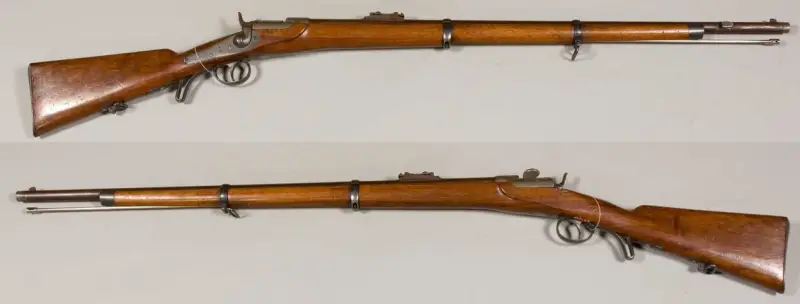
Werndl Jaeger rifle model 1867/77. Performance characteristics of the Werndl-Golub rifle. Weight – 4,2 kg (M1877) and 3,35 kg carbine of the same year. The length of the rifle is 1 mm, the carbine is 265 mm. Barrel length 1 mm. Cartridges: 044x84,6 mm R, 11,15x42 mm R (model 11,15). The initial bullet speed is 58–1877 m/s. Bullet weight 445 g. Army Museum, Stockholm
showed the dilapidation of the first;
and decaying and aging
close to destruction."Hebrews 8:13
People and weapon. Not long ago, materials devoted to Mannlicher rifles appeared on the pages of VO. The topic aroused interest and will be continued as color photo illustrations are prepared, which are not so easy to obtain.
For example, I know a museum where the Mannlicher rifle of 1895 is on display, but the caption under it reads: “Berdan rifle” and some unimaginable years are indicated. And you can’t change your signature! The display case is sealed and can only be opened when the exhibition changes.
But be that as it may, work on the cycle continues.
But many VO readers turned to me with a request to tell me about the small arms of the Austro-Hungarian army that were in service before the adoption of the Mannlicher rifle. And yes, indeed, the rifle that was “before” is worth a separate story. So we fulfill their request.
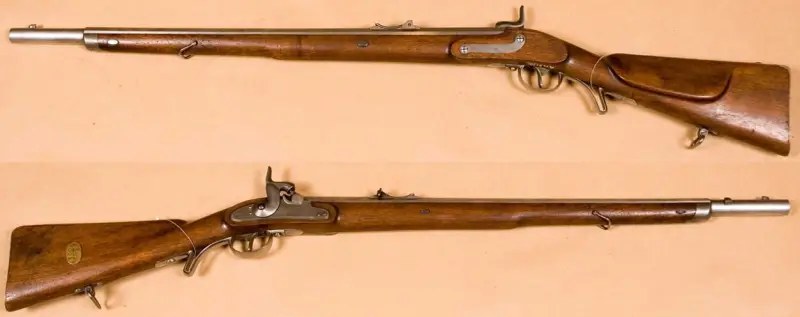
Jäger Lorenz carbine 1854 Army Museum, Stockholm

Lorenz rifle. Caliber – 13,716 mm. Weight - 4,25 kg without a bayonet and 4,61 kg with a bayonet. Barrel length – 952,5 mm, total length – 1 mm. Length with bayonet – 335 mm. Bullet weight - 1 g. Powder charge weight - 815 g of black powder. The initial bullet speed is 29,1 m/s. Sighting range - 4,2 m. Museum of American stories, Washington
And it so happened that after the humiliating defeat suffered in the war against Prussia in 1866, the general staff of the Austro-Hungarian Empire finally realized that small arms needed to be taken seriously and modernized following the example of all the others.
And it is not surprising that the Austrians lost this war, because the Austrian troops then still used Joseph Lorenz muzzle-loading rifles, speaking with them against the Prussians with their rapid-fire Dreyse needle rifles. True, they were superior to the “needle guns” in shooting accuracy and range, but were hopelessly inferior to them in rate of fire. In addition, it was very inconvenient to reload them in the “kneeling” position, and it was completely impossible to reload them “lying down”.
All this led to large losses in manpower and ultimately to defeat in the Austro-Prussian War. It is clear that the Lorenz guns, which had been in service since 1854, urgently needed to be replaced with something more modern, and most importantly, rapid-fire.
(The following are photographs by Allen Dobress).
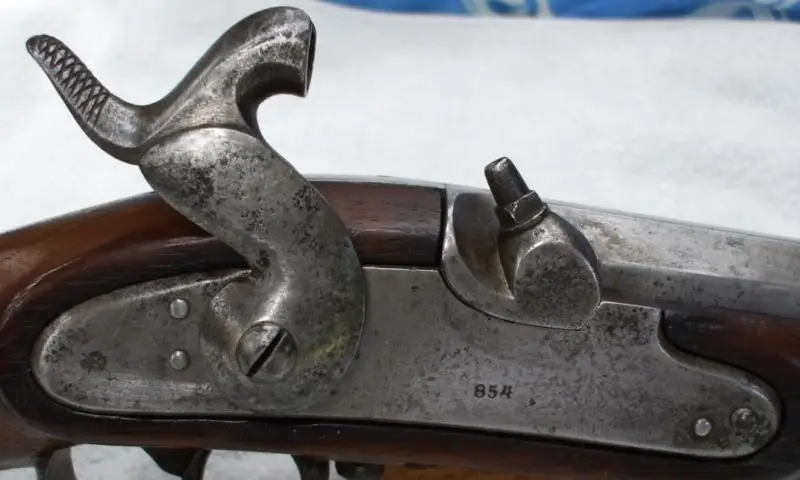
The Lorenz rifle's cap lock looked exactly like many other cap locks. The numbers “854” indicate the year of adoption - 1854...
And so, following the example of England, Russia and Spain, the Austrians decided that for the state treasury exhausted by the war it would be more profitable not to adopt a completely new rifle, but to convert the thousands of muzzle-loading guns in their arsenals into breech-loading ones.
The choice fell on the rifle of the Viennese gunsmith Franz Wenzl, who back in the 50s proposed a folding bolt (up and forward) and his own circular ignition cartridge 14x32 Wänzl RF, with a non-sheathed lead bullet with two flutes for internal settling and a blunt head. The barrel and trigger of the old Lorenz guns were kept unchanged, but a bolt box with a folding bolt was screwed onto the breech of the barrel.
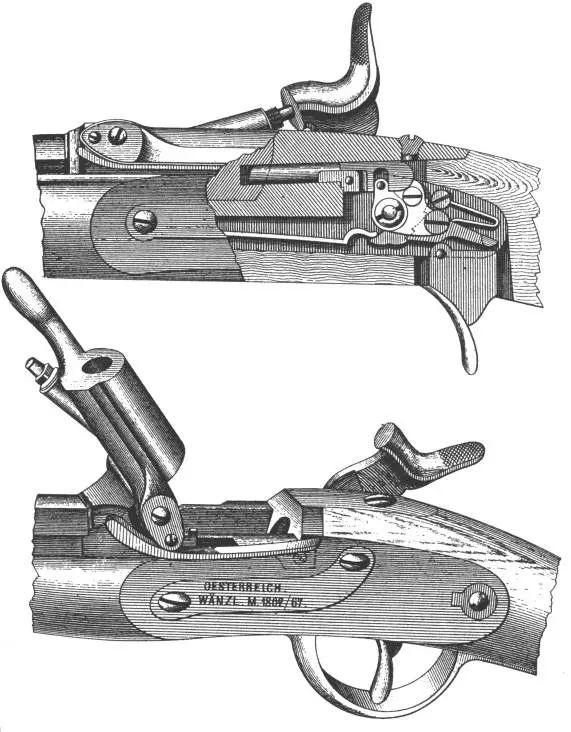
Diagram of the Werndl design flap lock
And I must say that, in general, his shutter turned out to be a successful design. Moreover, it seemed so interesting to the military of different countries that it caused many imitations in the form of the Albini-Brandlin systems, Lieutenant Baranov (the rifle with his lock was in service with the Russian Imperial fleet, and we will definitely tell you about it someday), Milbank-Amsler, Tersen, Berdan, Allen-Springfield, Springfield 1871 and a number of others.
In total, more than 70 rifles were converted in this way, which made it possible to at least teach soldiers how to handle and shoot new weapons.
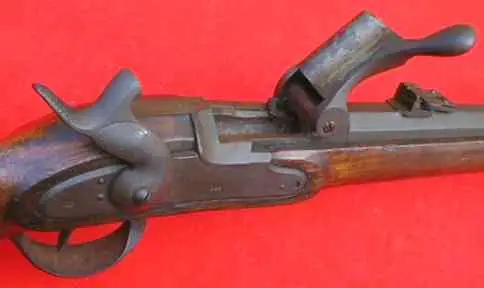
This is how this bolt was folded forward by the handle located on the right.
Remington rifles with a crane bolt were also tested in Austria, but the tests, in which Emperor Fratz Joseph himself took part, ended in failure for a number of reasons, and the American rifle was not accepted for service.
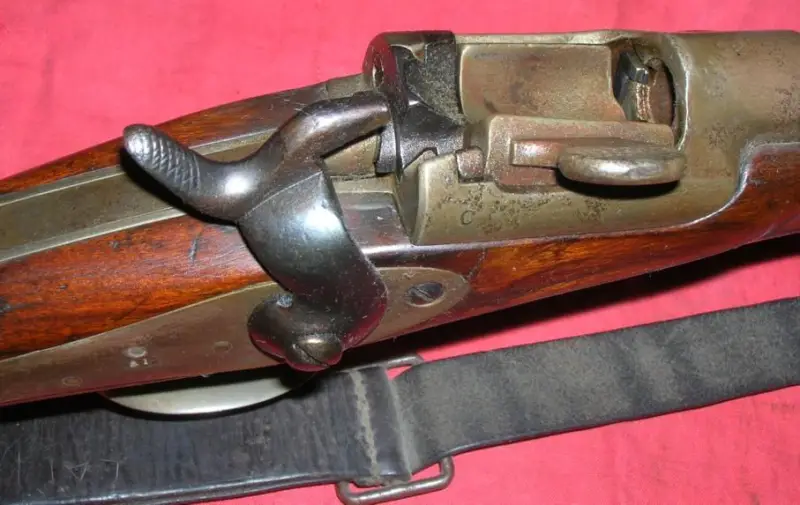
Joseph Werndl's shutter in the open state. To bring the rifle into combat-ready condition and fire from it, it was necessary to cock the hammer, then with the thumb of the right hand press on the bolt “ear” on the left and turn the bolt all the way to the right so that the hole in the chamber opens. The bolt was a cylinder with a recess for the cartridge, so in this position the cartridge could be freely inserted into the chamber. And the hammer, which was hit by the trigger, passed through the bolt itself. It also acted on the spring-loaded extractor, which, after the bolt was fully open, ejected the empty cartridge case from the chamber. This device made it possible to fire up to 20 rounds per minute, which was an excellent indicator for those years.
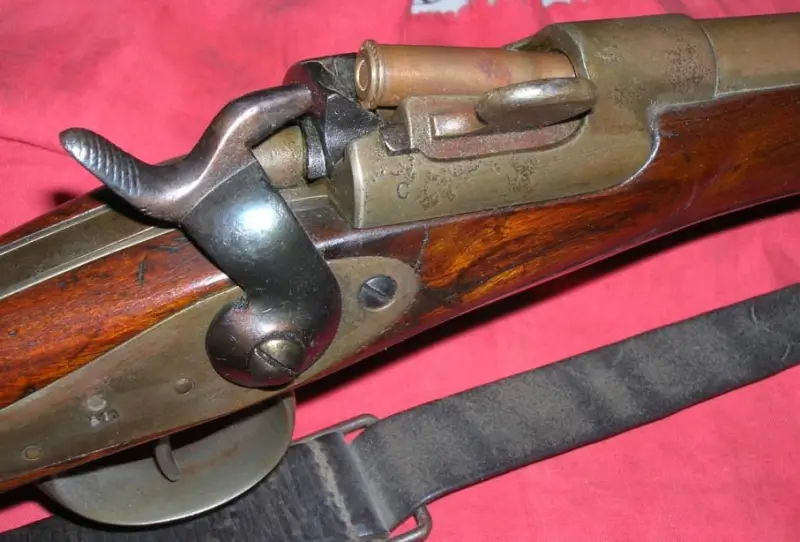
The cartridge is halfway inserted into the chamber
It was after this failure that Joseph Werndl (1831–1889), the founder of the famous and famous Österreichische Waffenfabrik Gesellschaft from Steyr, appeared on the scene, proposing his design, created together with the engineer Karl Joseph Golub. The peculiarity of the bolt of this rifle was that the bolt did not recline, but rotated, and not on the transverse axis, like the Remington, but on the longitudinal one.
Tests of the new rifle were carried out at the Vienna Arsenal training ground by soldiers of the 21st Jaeger Battalion. And they demonstrated that the Austrian rifle was capable of providing shooting accuracy equal to that of the Remington.
Moreover, it turned out that it could achieve a rate of fire that exceeded the rate of fire of the “American” by 20% - a very high figure for that time. Naturally, good is not sought from good, and in 1867 the Werndl-Golub rifle was put into service under the name “Infantry rifle model 1867 caliber 11,4x50 R Werndl.
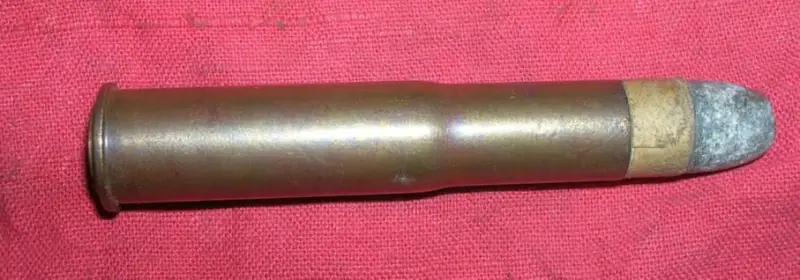
Josef Werndl's cartridge, like many rifle cartridges of the time, had a lead bullet wrapped in paper
Incredible but true: Werndl did not demand money from the state for the use of his patent. However, this decision was dictated not so much by patriotic ideals as by the realization that only he was capable of producing new weapons in the required quantity, of appropriate quality and in the time frame that would be required to equip the army and such territorial militias as the Landwehr and Landsturm.
That's how 600 Model 000 rifles were produced in infantry and ranger versions.
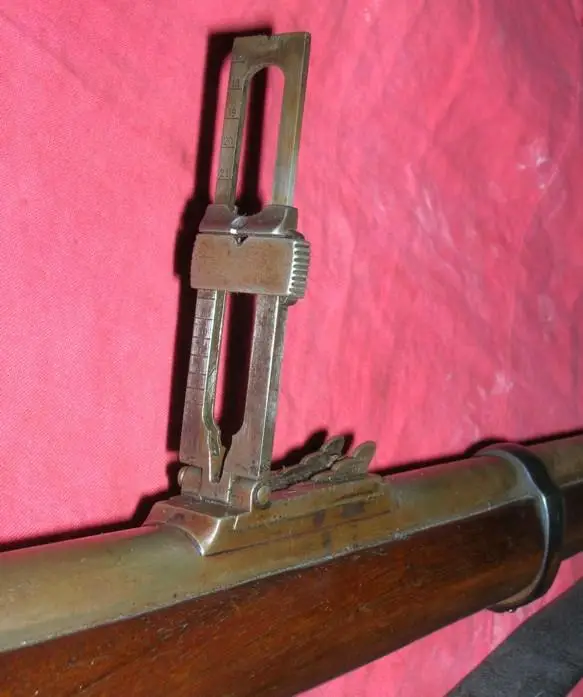
Werndl rifle frame sight
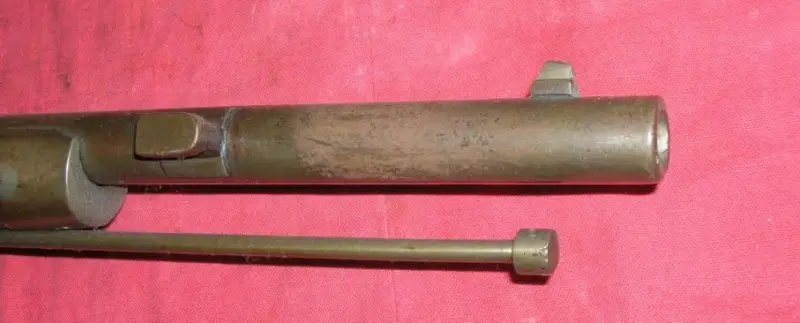
Cleaning rod, barrel and bayonet mount on the barrel of a Werndl rifle

Bayonet and scabbard
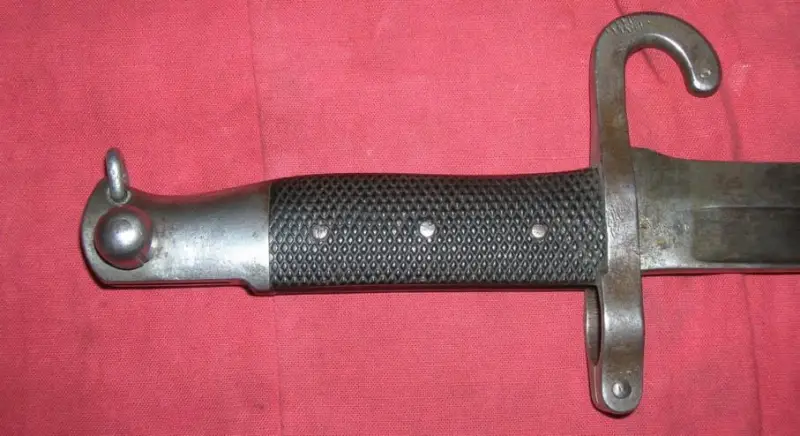
Werndl rifle bayonet handle

After the Werndl rifles were replaced by Mannlicher rifles, some of them were converted into hunting rifles
Moreover, the huntsmen’s rifles differed only in the pistol-shaped trigger guard. In 1873, an improved version of the M.1873 rifle appeared, and from 1877, to standardize the caliber of 309 M.000 and M.1867 rifles, it was changed to use the new M.1873 cartridge, better known as 1877x11,15R.
The Werndl rifles were removed from service with the linear units after the Mannlicher bolt-action rifles M.1886, M.1888 and M.1895 entered service. But during the First World War, due to a lack of weapons in the Austro-Hungarian troops, they began to be widely used.
That is, the situation with these rifles turned out to be similar to what happened in Russia with the Berdan rifles, which during the war, due to a shortage of modern rifles, were also transferred to army units, not only the second, but also the first line.
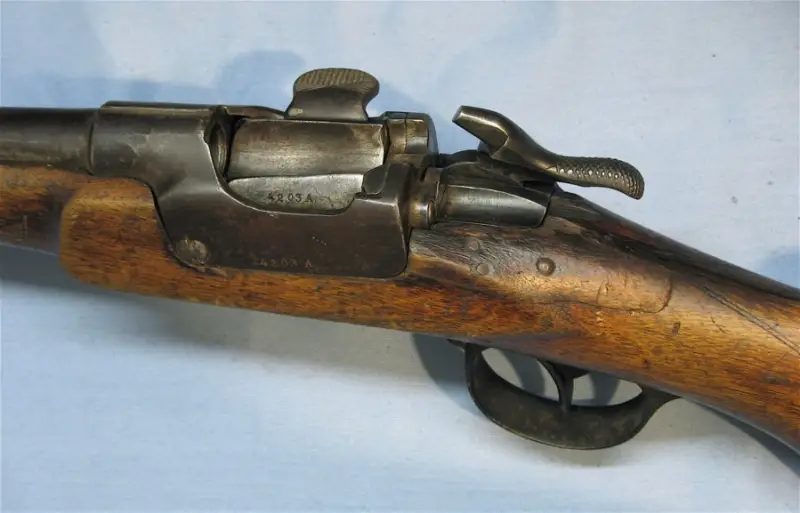
The bolt of a hunting rifle based on the Werndl rifle. Left view. Shutter is open
Information